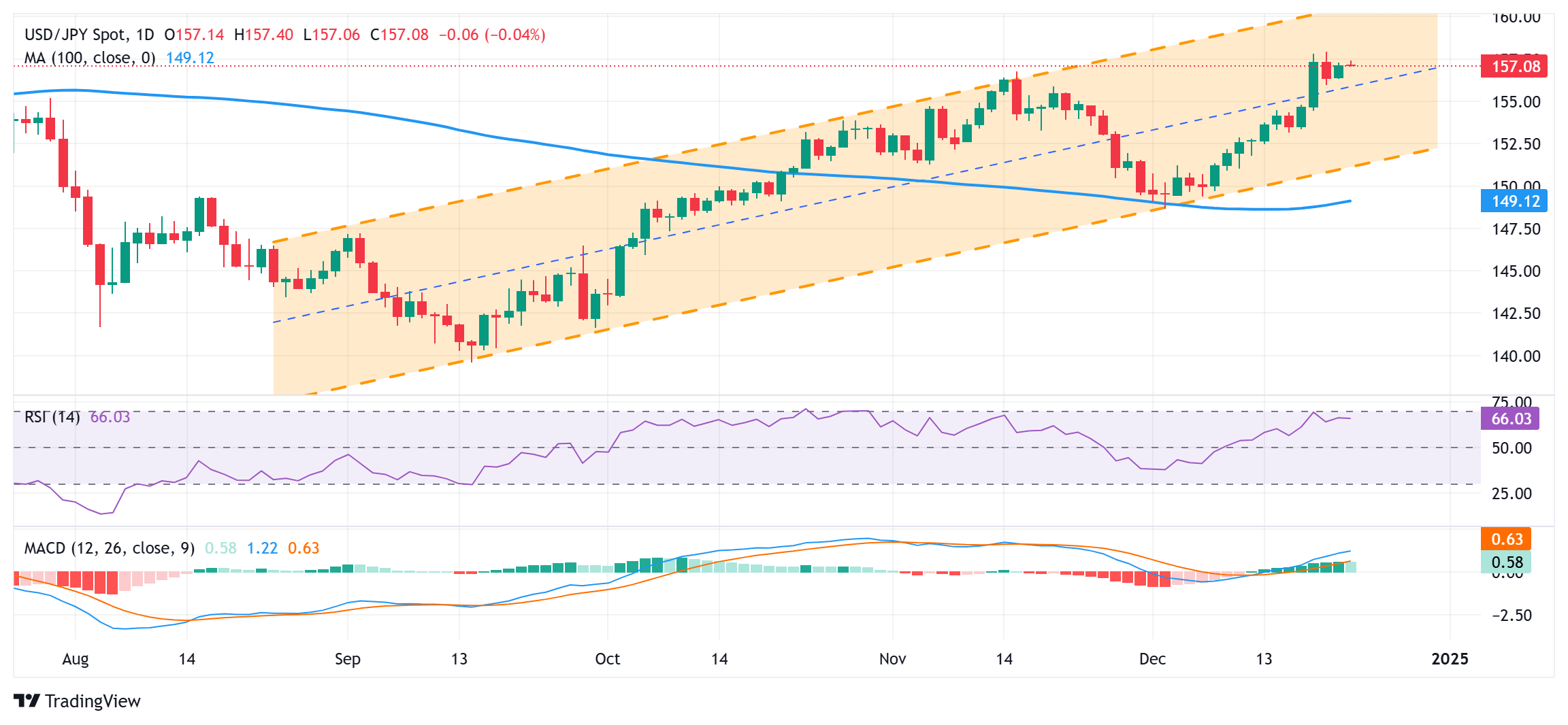Japanese Yen remains vulnerable amid doubts over BoJ’s rate-hike plans
- The Japanese Yen remains depressed near a multi-month low against the USD.
- The BoJ’s dovish stance and a positive risk tone undermine the safe-haven JPY.
- The Fed’s hawkish outlook for 2025 acts as a tailwind for the USD/JPY pair.
The Japanese Yen (JPY) continues with its relative underperformance against its American counterpart for the second straight day on Tuesday and remains close to the multi-month low touched last week. The Bank of Japan (BoJ) last week opened up the possibility of waiting longer for the next hike, while the Federal Reserve (Fed) signaled a slowdown in the pace of monetary easing next year. This, in turn, tempers expectations of a sharp narrowing in the US-Japan rate differential and turns out to be a key factor undermining the JPY.
Apart from this, a generally positive tone around the equity markets further dents demand for the safe-haven JPY, which moved little following the release of the October BoJ meeting Minutes. This, along with a bullish US Dollar (USD), bolstered by the Fed's hawkish shift, assists the USD/JPY pair to hold above the 157.00 mark during the Asian session. That said, the recent inflation data from Japan keeps the door open for a potential BoJ rate hike in January or March. This might hold back the JPY bears from placing aggressive bets.
Japanese Yen continues with its struggle to lure buyers amid BoJ rate-hike uncertainty
- The Bank of Japan October meeting Minutes released this Tuesday reiterated the possibility of gradual rate hikes if inflation trends align with expectations, with a potential path to 1.0% by late fiscal 2025.
- The BoJ Minutes also emphasized a cautious approach to monetary policy, wage-driven economic growth amid domestic and global uncertainties and fiscal measures to counter deflationary pressures.
- BoJ Governor Kazuo Ueda said last week that the central bank preferred to await data on whether wages would retain their upward momentum next year and to gain clarity on Trump's economic policies.
- Investors now seem convinced that the BoJ will not hike interest rates at its next monetary policy meeting in January and wait until March, which, in turn, continues to undermine the Japanese Yen on Tuesday.
- As the market continues to adjust to the Federal Reserve's (Fed) less dovish outlook for 2025, the yield on the benchmark 10-year US government bond shot to its highest level since May the previous day.
- The US Dollar remains close to a two-year peak and seems unaffected by a slight disappointment from the Conference Board's US Consumer Confidence index, which fell to 104.7 from 111.7 previously.
- Investors now look to the release of the Richmond Manufacturing Index from the US for some impetus amid relatively thin trading volumes on Christmas Eve.
USD/JPY seems poised to retest multi-month top and prolong the appreciating trend
From a technical perspective, the multi-month top, around the 158.00 neighborhood touched last Friday, could act as an immediate hurdle. A sustained strength beyond the said handle will be seen as a fresh trigger for bulls and lift the USD/JPY pair to the 158.45 intermediate resistance en route to the 159.00 mark amid positive oscillators on the daily chart.
On the flip side, weakness below the 157.00 round figure now seems to find decent support near the 156.65 horizontal zone, below which the USD/JPY pair could slide to the 156.00 mark. Any further decline could be seen as a buying opportunity near the 155.50 region and seems limited near the 155.00 psychological mark. The latter should act as a strong base for spot prices.
Japanese Yen FAQs
The Japanese Yen (JPY) is one of the world’s most traded currencies. Its value is broadly determined by the performance of the Japanese economy, but more specifically by the Bank of Japan’s policy, the differential between Japanese and US bond yields, or risk sentiment among traders, among other factors.
One of the Bank of Japan’s mandates is currency control, so its moves are key for the Yen. The BoJ has directly intervened in currency markets sometimes, generally to lower the value of the Yen, although it refrains from doing it often due to political concerns of its main trading partners. The BoJ ultra-loose monetary policy between 2013 and 2024 caused the Yen to depreciate against its main currency peers due to an increasing policy divergence between the Bank of Japan and other main central banks. More recently, the gradually unwinding of this ultra-loose policy has given some support to the Yen.
Over the last decade, the BoJ’s stance of sticking to ultra-loose monetary policy has led to a widening policy divergence with other central banks, particularly with the US Federal Reserve. This supported a widening of the differential between the 10-year US and Japanese bonds, which favored the US Dollar against the Japanese Yen. The BoJ decision in 2024 to gradually abandon the ultra-loose policy, coupled with interest-rate cuts in other major central banks, is narrowing this differential.
The Japanese Yen is often seen as a safe-haven investment. This means that in times of market stress, investors are more likely to put their money in the Japanese currency due to its supposed reliability and stability. Turbulent times are likely to strengthen the Yen’s value against other currencies seen as more risky to invest in.

